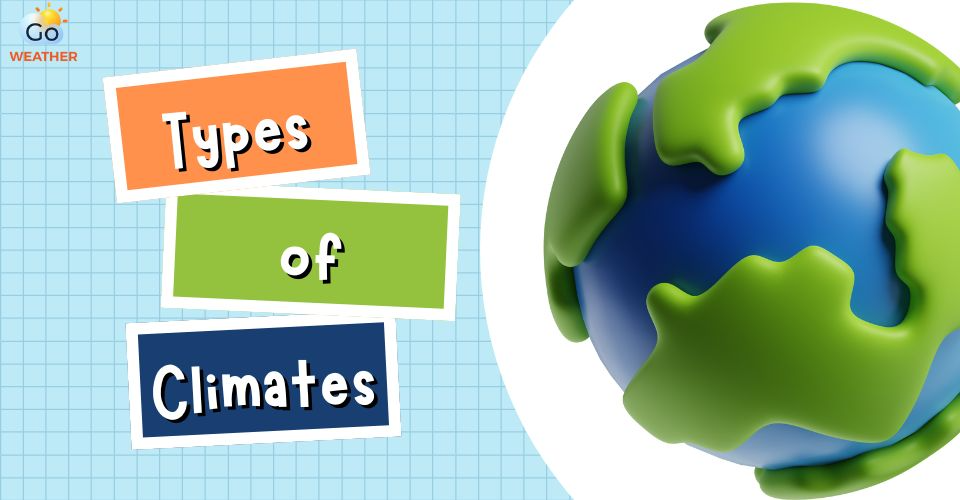9 Extreme Weather Conditions Around the World to Watch Out for
The periodicity and intensity of extreme weather conditions have increased as a result of human-induced global warming. They have wreaked havoc on human society and natural ecosystems as well. So, what are the common severe weather conditions? How to stay safe when they hit us? Keep reading on!
.jpg)
Aware of extreme weather conditions
What Are Extreme Weather Conditions?
Extreme weather refers to any dangerous meteorological phenomena that have the potential to cause damage, severe social instability, or death.
The types of extreme weather events vary depending on the longitude, latitude, topography, and atmospheric conditions.
.jpg)
Extreme weather conditions definition
Strong winds, hail, excessive rainfall, and wildfires are all forms and effects of extreme weather, as well as thunderstorms, downbursts, lightning, cyclones, tornadoes, tropical storms, and tropical storms.
Extreme weather develops seasonally and geographically, such as snowstorms and dust storms.
What Causes Extreme Weather Conditions?
Extreme weather conditions are caused by a combination of natural and human-induced factors, leading to significant disruptions in climate patterns.
Natural causes include atmospheric phenomena like hurricanes, tornadoes, and thunderstorms, driven by imbalances in air pressure, ocean temperatures, and moisture levels.
.jpg)
Causes of extreme weather conditions
Climate change, fueled by human activities such as deforestation and greenhouse gas emissions, intensifies these events by altering global weather systems.
For instance, warmer ocean temperatures can strengthen hurricanes, while rising global temperatures contribute to prolonged droughts and heatwaves.
Types of Extreme Weather Conditions
Flood
Flooding is an overflow of water that submerges land and is one of the deadliest types of severe weather. Floods can look very different, build gradually, and come on quickly.
It occurs for many different reasons, causing damage to people in both health and property. Here are some:
-
Heavy Rainfall: Prolonged or intense rainfall can overwhelm drainage systems and riverbanks, leading to flooding.
-
Snowmelt: Rapid melting of snow, often during spring, can cause rivers to overflow.
-
Storm Surges: Coastal flooding caused by strong winds pushing seawater onto the land, often during hurricanes or cyclones.
-
Dam Failures: Structural failures in dams or levees can release large volumes of water into surrounding areas.
-
Urbanization: Impervious surfaces like roads and buildings prevent water absorption into the ground, increasing runoff during rains.
-
Deforestation: Removal of trees reduces water absorption and increases runoff, contributing to floods.
.jpg)
Flood
Safety tips:
-
Stay up to date with weather conditions alerts, warnings, and severe weather advice.
-
Follow instructions from public safety officials
-
Move your property to a low-risk area
-
Stay away from flooded areas, drains, ditches, and fast-moving water. Move to higher ground.
-
Unplugging electronic devices before flooding occurs. Never touch electrical equipment if you are wet.
-
Assemble an emergency kit.
-
Avoid walking in floodwaters.
-
Avoid driving into the water of unknown depths or around barricades.
Drought
Drought refers to a prolonged period of water shortages in a specific area caused by abnormally low rainfall and dry weather. It is considered one of the most dangerous, bad weather conditions.
There are four types of drought:
|
Meteorological drought |
It happens when dry weather dominates an area. |
|
Hydrological drought |
It occurs when low water supplies become apparent, especially in streams, reservoirs. |
|
Agricultural drought |
It happens when crops become affected. |
|
Socioeconomic drought |
It occurs when the demand for an economic commodity exceeds supply due to a weather-related shortage of water supply. |
Drought can have detrimental impacts on health problems, air quality, hygiene, food, and nutrition. It leads to water supply problems and diseases in the affected areas.
.jpg)
Extreme weather conditions negatively impact humans
Safety tips:
-
Get informed with early warnings from meteorologists
-
Don’t pour water down the drain if it can be used for other purposes.
-
Fix dripping faucets to save water
-
Check all plumbing for leaks and have them fixed
-
Store water
-
Install the most water-efficient irrigation devices for each use, such as microbiology and drip irrigation systems, and sprinklers.
Heatwaves
Heatwaves are periods of excessively hot weather accompanied by high levels of humidity. There are different definitions for heat waves as temperatures vary in different geographic locations.
A heatwave can less be known as a form of extreme weather since it’s invisible, unlike other forms like hurricanes and tornadoes.
So, what causes a heatwave? They are derived from trapped air. When air is trapped over one region due to high-pressure systems, sunlight will warm it up to uncharacteristic temperatures.
.jpg)
Heatwaves
Heatwaves are among the most extreme weather conditions but receive less attention as their destruction is not always evident.
Heatwaves can pose a threat to humans and ecosystems. Long exposure to heat can negatively impact our health. People may lose their crops or livestock owing to extreme heat.
Safety tips:
-
Check the weather forecast to get warnings about upcoming heatwaves
-
Draw your curtains and awnings and turn on your air conditioner
-
Stay hydrated by drinking two to three litres of water each day
-
Stay out of the sun
-
Learn hot weather advice for seniors and look after your pets
Cold waves
A cold wave occurs when temperatures fall rapidly within 24 hours. This minimum temperature varies among geographical regions and at different times of the year.
Cold waves can occur in any geological location and are formed by the accumulation of large cool air masses across certain regions.
.jpg)
Cold waves
This weather condition can have detrimental impacts on livestock and wildlife. When accompanied by heavy and persistent snow, a cold wave may limit the ability of grazing animals to reach necessary food and water.
As a result, they can die of hypothermia or starvation.
Safety tips:
-
Avoid going outside as much as possible
-
Listen to the radio for weather forecasts and weather reports
-
Close off heat in some rooms to conserve fuel
-
Dress in layers
-
Pay attention to signs of frostbite, such as loss of feeling, pale fingers, and pale toes
-
If trapped in the car, pull off the highway and turn on the hazard lights
Tornado
A tornado is one of the most devastating extreme weather conditions. They are vertical funnels of rapidly spinning air moving at speeds of about 16 to 32 kilometers per hour (10 to 20 miles per hour).
Their winds can top 402 kilometers per hour (250 miles per hour). Tornadoes usually last less than 10 minutes in any place in the world, but mostly in the United States.
.jpg)
Tornado
Tornadoes form when warm, moist air collides with cold, dry air. Denser cold air is pushed through the warm air, often creating thunderstorms.
They can cause tremendous destruction with winds of up to 300 miles per hour. They can destroy large buildings, uproot trees, and flip vehicles.
Safety tips:
-
Listen to the radio or check weather online to stay informed about severe weather conditions.
-
Prepare a plan and an emergency kit.
-
Go to the basement or a small interior room.
-
When you’re outside, get to the nearest shelter. If there isn’t any shelter, stay in the vehicle with your seatbelt on. Cover your head and put it down.
-
Stay away from windows.
-
Do not try to outrun the tornado in your car.
Lightning
Lightning is a natural electrical discharge that happens when there is an imbalance between storm clouds and the ground. Three common types of lightning are cloud-to-ground, cloud-to-cloud, and cloud-to-air.
Lightning can create heat that is four times greater than the sun. It is not only seen during thunderstorms but also in volcanic eruptions, extremely intense wildfires, surface nuclear detonations, massive snowstorms, and during major hurricanes.
Lightning can cause cardiac arrest, burns, permanent brain damage, memory loss, or even death.
.jpg)
Lightning
Safety tips:
-
Stay indoors as much as possible.
-
Stay off windows and doors.
-
Turn off electronic devices.
-
Stay away from sinks, tubs, anything metal, pools, and lakes.
-
Avoid concrete floors and walls, and corded phones.
-
Avoid open spaces, but never shelter under a big tree.
Dust storm
A dust storm is one of the most violent and extreme weather events that occur when very strong winds carry clouds of dust across an area.
The blowing wind filled the air with sand and dust, severely restricted visibility, and delayed traffic. Sand and dust storms are associated with increased emergency department visits and hospital admissions, as well as increased exacerbations of asthma and respiratory illness.
.jpg)
Dust storm
Safety tips:
-
If you observe dense dust approaching the roadway, pull your vehicle over the curb as far as possible, stop, turn off the lights, and remove your foot from the brake pedal.
-
Avoid the dust storm area as much as possible.
-
If you have no choice but to stay on the roadway, drive at a suitable speed for visibility, and turn on lights.
-
Check traffic around your vehicle to slow down.
-
Never stop in a travel lane or the emergency lane.
-
Close all windows and convert the vehicle's ventilation system to recirculating air
-
Stay in your vehicle and wait for the storm to pass.
Blizzard
A blizzard refers to a severe snowstorm with intensely strong winds and low visibility. Snow is not falling but loose snow on the ground is lifted and blown by strong winds.
To avoid hypothermia if caught outdoors during a blizzard, drink enough fluids and get some nutrients. Move around to keep blood flowing.
.jpg)
Blizzard
Safety tips:
-
Check the local weather forecast and follow weather reports and warnings to know the storm's timeline.
-
Make sure to charge your electronic devices.
-
Pack an emergency aid kit in case your car breaks down or you get into an accident.
-
When it snows heavily, keep your dog on a leash while walking and add some colorful identification tags to the collar.
-
Dress is the most effective way to insulate your body. Choose proper snow weather outfits to beat the cold.
-
Never use a generator indoors.
Hurricanes
Hurricanes, or cyclones, are one of the most common extreme weather conditions. Hurricanes are giant, spiraling tropical storms.
They include strong winds of over 257 kilometers per hour (160 miles per hour). Also, they bring heavy rains that can drop more than 9 trillion liters (2.4 trillion gallons) of rain a day.
► Related: What is the difference between storm and hurricane?
.jpg)
Hurricanes
Safety tips:
-
Create an emergency supply kit.
-
Help parents prepare for bad weather.
-
Stay indoors. during a hurricane
-
Follow local radio/TV stations for weather and specific instructions.
-
Immediately evacuate the area when told by local officials.
-
If your home is on lower ground, move to a shelter.
Conclusion
Severe weather events are serious and dangerous. In order to stay safe and unharmed, you must learn about the necessary safety precautions and tips. We hope the information on common extreme weather conditions provided in this article will help make sure you don’t put yourself at a heightened risk.




![What is the Difference Between Storm and Hurricane? [Complete Guide]](https://admin.goweatherforecast.com/images/1732850306.png)






0 Comments
Leave a Comment
Your email address will not be published. Required fields are marked *